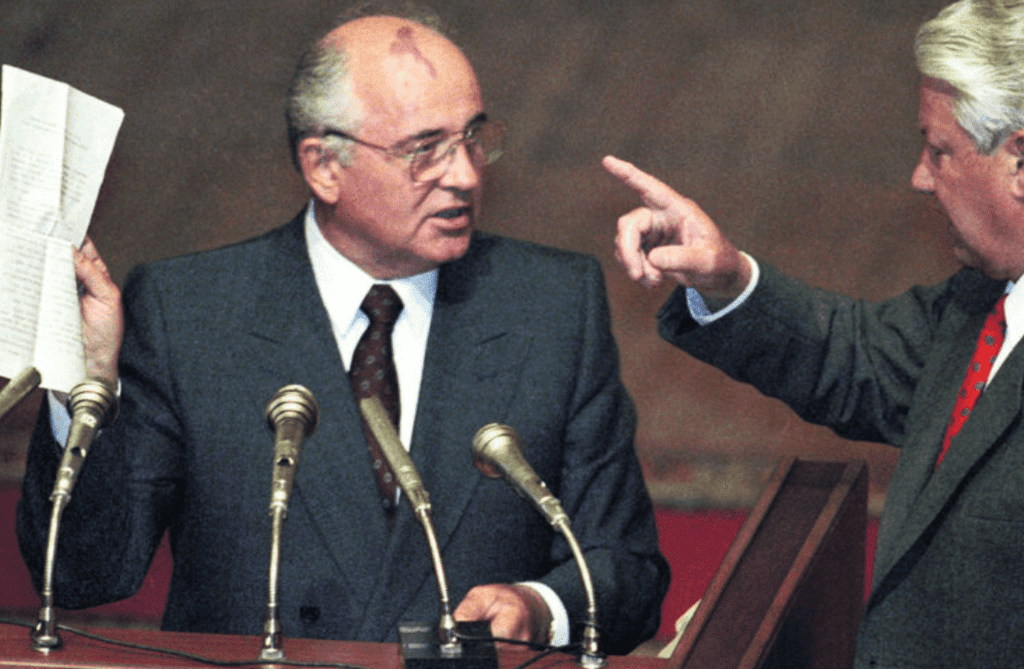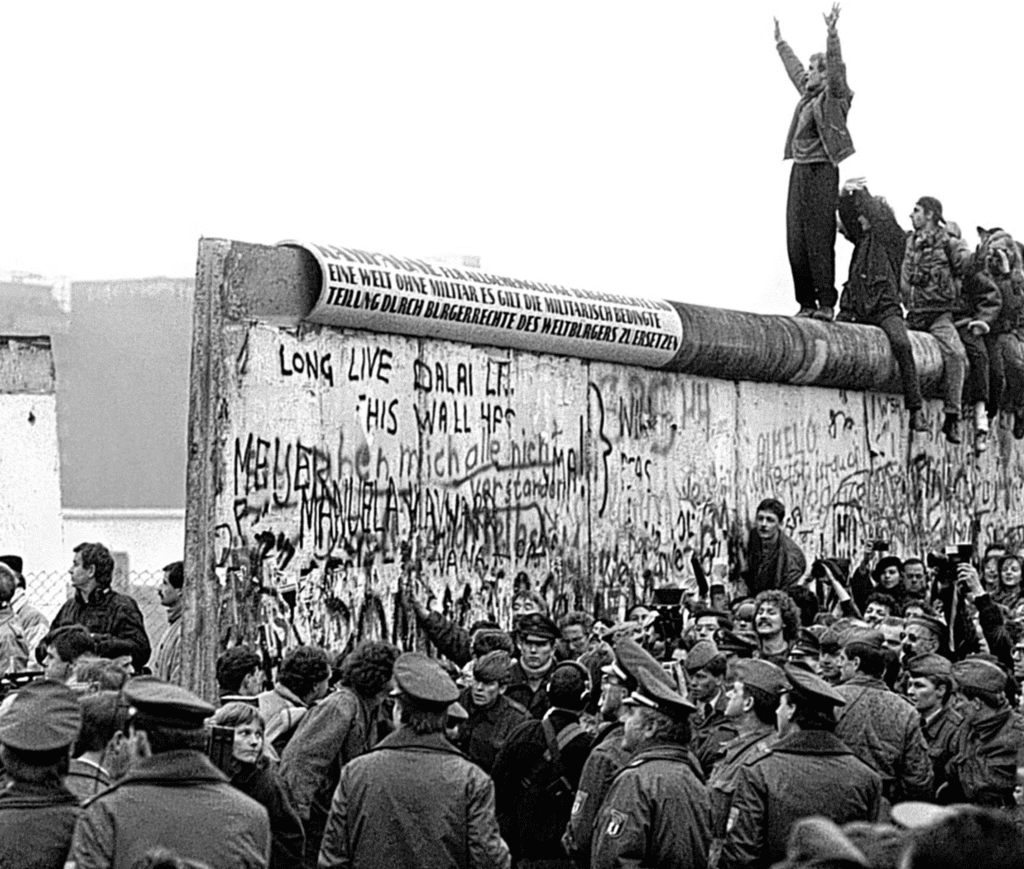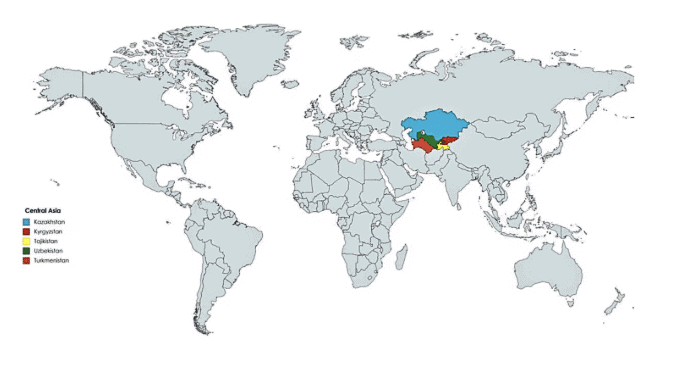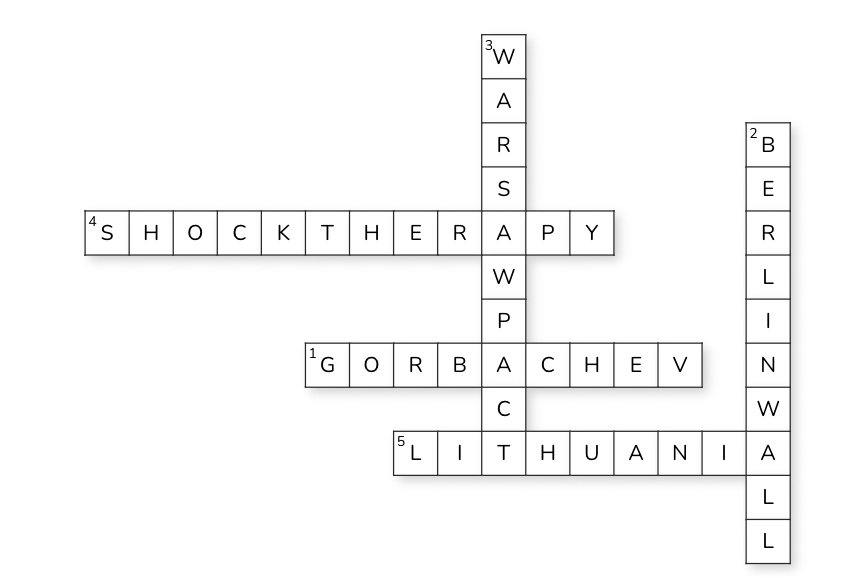Assignment: The End of Bipolarity | Political Science Class 12 - Humanities/Arts PDF Download
| Table of contents |

|
| Multiple Choice Questions (MCQs) |

|
| Short Q/A |

|
| Competency-Based Questions |

|
| Crossword |

|
Multiple Choice Questions (MCQs)
Q1. Which event marked the symbolic end of the Cold War?
a) Fall of the Berlin Wall
b) Formation of the Warsaw Pact
c) Gorbachev's reforms
d) Disintegration of the USSR
Ans: a) The fall of the Berlin Wall in 1989 marked the symbolic end of the Cold War.
Q2. Who was the leader of the Soviet Union during its disintegration in 1991?
a) Joseph Stalin
b) Nikita Khrushchev
c) Mikhail Gorbachev
d) Boris Yeltsin
Ans: c) Mikhail Gorbachev was the leader of the Soviet Union during its disintegration in 1991.
Q3. Which country was the first to declare its independence from the USSR in 1990?
a) Lithuania
b) Ukraine
c) Estonia
d) Latvia
Ans: a) Lithuania was the first of the 15 Soviet republics to declare its independence in 1990.
Q4. What was the economic system of the USSR based on?
a) Capitalism
b) Socialism
c) Mixed economy
d) Feudalism
Ans: b) The USSR had a socialist economic system.
Q5. What was the primary purpose of Gorbachev’s reforms?
a) To strengthen the Communist Party
b) To maintain the Soviet Union as a superpower
c) To democratize and modernize the Soviet Union
d) To increase military dominance
Ans: c) Gorbachev's reforms aimed at democratizing and modernizing the Soviet Union.
Short Q/A
Q1. What was the role of the Warsaw Pact?
Ans: The Warsaw Pact was a military alliance formed by the USSR and its Eastern European allies to counter the North Atlantic Treaty Organization (NATO) during the Cold War.
Q2. Why did the Soviet Union collapse in 1991?
Ans: The Soviet Union collapsed due to economic stagnation, political inefficiency, and the rise of nationalist movements within the republics. Gorbachev’s reforms, though necessary, led to a loss of control, disintegrating the USSR.
Q3. How did the end of the Cold War impact global power dynamics?
Ans: The end of the Cold War led to the emergence of the US as the sole superpower, resulting in a unipolar world order. The ideological struggle between capitalism and socialism ended, and liberal democracy became the dominant political system.
Q4. What is ‘shock therapy’ and how did it affect Russia?
Ans: Shock therapy was a drastic economic transition from socialism to capitalism, involving rapid privatization and liberalization. In Russia, it led to economic instability, high inflation, and an increase in inequality.
Q5. What was the significance of the Berlin Wall falling in 1989?
Ans: The fall of the Berlin Wall symbolized the end of communist rule in Eastern Europe, leading to the unification of Germany and signaling the collapse of the Soviet bloc.
Competency-Based Questions
Q1. Locate and mark the Central Asian republics on a world map. Label them and provide a brief description of each country's political and economic status before and after the collapse of the Soviet Union.
Ans: The Central Asian republics include Kazakhstan, Kyrgyzstan, Uzbekistan, Turkmenistan, and Tajikistan.
Before the collapse: These countries were part of the Soviet Union under communist rule.
After the collapse: They became independent nations, transitioning to mixed economies with varying degrees of democratic governance. Most have remained authoritarian, with Russia maintaining significant influence over the region.
Q2. Find out how the collapse of the Soviet Union influenced global politics, particularly in terms of power dynamics and international alliances.
Ans: End of Bipolarity and Emergence of Unipolarity
- The collapse of the Soviet Union in 1991 marked the end of the bipolar world order, where two superpowers, the US and the USSR, dominated global politics.
- With the Soviet Union’s dissolution, the United States emerged as the sole superpower, leading to a unipolar world order.
Transition of Former Soviet States
- Many former Soviet republics transitioned to market economies and liberal democracies, embracing capitalist principles and democratic governance.
- However, some countries, particularly in Central Asia, maintained strong political and economic ties with Russia, reflecting a mixed trajectory of development.
Expansion of NATO and the European Union
- The breakup of the Soviet Union facilitated the expansion of NATO (North Atlantic Treaty Organization) and the European Union, as former Soviet states and Eastern European countries sought security and integration with Western institutions.
- This expansion shifted global alliances and altered power dynamics, as new member states aligned more closely with the US and Western Europe.
Q3. Look at the following data and answer the following questions
- In 1989, the GDP of the USSR was $2.66 trillion, but by 1991, it had fallen sharply.
- Inflation rose above 1000% after shock therapy.
- Nearly 50% of the population fell below the poverty line in Russia during the early 1990s.
a) Using the data, explain why the Soviet economy collapsed so rapidly.
b) What lessons can developing countries like India learn about sudden transition from a state-controlled economy to a market economy?
Ans: a)
- Economic Crisis: The sharp fall in GDP showed deep industrial decline.
- Hyperinflation: Inflation above 1000% destroyed the value of currency and people’s savings.
- Poverty & Hardship: Almost half the population fell below poverty line, showing failure of reforms.
- Impact of Shock Therapy: Sudden shift from socialism to capitalism led to collapse of state-controlled industries, unemployment, and shortage of goods.
The data reflects that the USSR’s centrally planned economy could not handle rapid liberalisation, and this economic failure was a key factor in the disintegration of the Soviet Union (1991).
b)
- Gradual Transition Needed: Economic reforms must be implemented step by step, not suddenly.
- Social Security Measures: Safeguards should be provided for weaker sections during liberalisation.
- Strong Institutions: A stable banking system and regulatory framework must guide reforms.
- Balance of State & Market: Welfare policies of the state should continue while opening up to global markets.
- Democratic Accountability: Reforms must be transparent and accountable to avoid alienation of citizens.
India, unlike the USSR, adopted a gradual approach to liberalisation (1991 economic reforms), ensuring stability, democracy, and continuity of welfare policies. This avoided the economic and political collapse that the USSR faced.
Q4. Problem-Solving
After the disintegration of the USSR, India faced a dilemma: it had strong historical ties with Russia but also needed to open up to the Western world for economic and technological cooperation.
a) If you were an Indian policymaker in 1991, what foreign policy approach would you adopt?
b) How did India actually balance its relations with both Russia and the USA after 1991?
Ans: a) As a policymaker, I would adopt a balanced and multi-aligned approach, ensuring India’s interests with both Russia and the Western world:
- Continue Strong Ties with Russia: Maintain defense, energy, and political cooperation based on historic trust.
- Engage with the West: Open up to the USA and Europe for technology, investment, and markets, especially after India’s 1991 economic reforms.
- Strategic Autonomy: Avoid dependence on any single power bloc and preserve India’s independent decision-making.
- Diversification: Build relations with emerging Asian powers (Japan, ASEAN, China) to widen India’s options.
b) With Russia:
- Continued strong defense partnership (arms, aircraft, submarines).
- Cooperation in nuclear energy, oil, and space research.
- Signed the India-Russia Strategic Partnership (2000) to deepen ties.
With the USA:
- Improved trade and investment relations after 1991 economic reforms.
- Cooperation in IT, education, science, and counter-terrorism.
- Civil Nuclear Agreement (2008) marked a new level of trust.
Independent Policy:
- India successfully kept strong ties with Russia while improving relations with the USA.
- This reflects India’s aim for a multipolar world and independent foreign policy.
Crossword
Q1: Solve the following crossword using the clues given below:
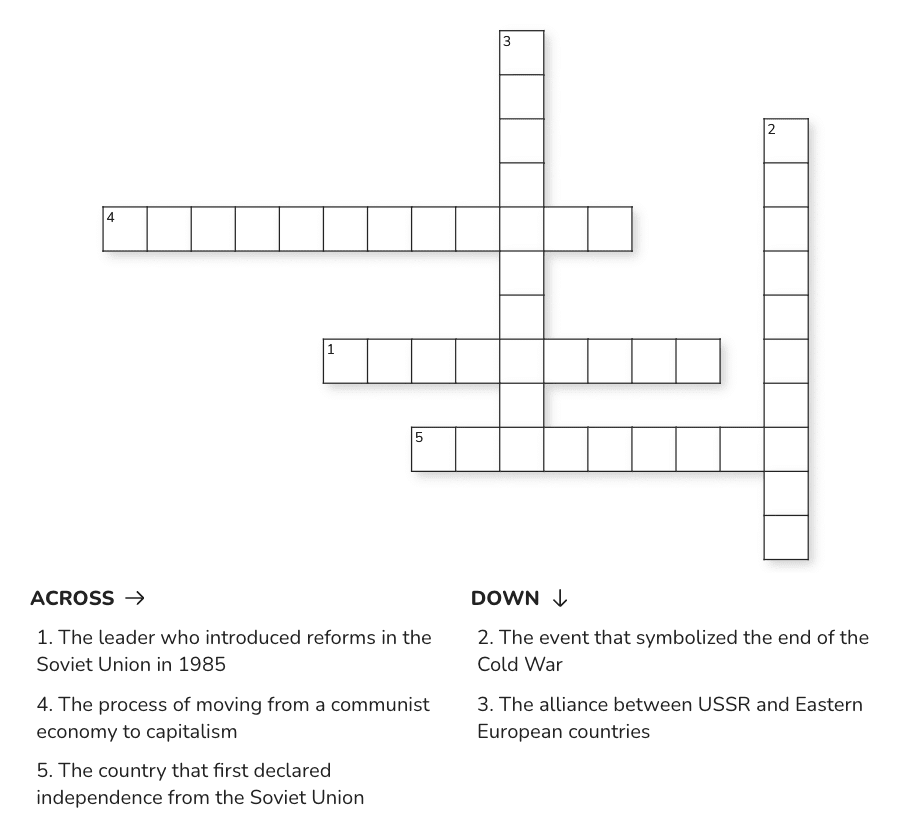
Ans:
|
34 videos|308 docs|51 tests
|
FAQs on Assignment: The End of Bipolarity - Political Science Class 12 - Humanities/Arts
| 1. What does the term "End of Bipolarity" refer to in the context of international relations? |  |
| 2. How has the end of bipolarity impacted global politics? |  |
| 3. What are some consequences of moving away from a bipolar world? |  |
| 4. What role do non-state actors play in the post-bipolar world? |  |
| 5. Can the concept of bipolarity still be relevant in today's global affairs? |  |

